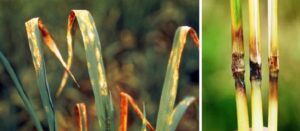Rice is a staple crop in Bangladesh and many parts of the world. But one of the deadliest threats to rice production is blast disease, caused by a fungus called Magnaporthe oryzae. It can wipe out 30–70% of a harvest if not managed early.
In this guide, we’ll show how to spot rice blast disease, what causes it, and how to prevent it using both organic and chemical methods.
⚠️ What is Blast Disease?
Blast disease is a fungal infection that attacks rice plants at various stages — from seedlings to grain filling. It spreads rapidly in warm, humid conditions, especially in fields with poor airflow or water management.
Causes of Rice Blast
-
High humidity (>90%) and temperature (25–30°C)
-
Excessive nitrogen fertilizer
-
Poor air circulation among dense crops
-
Infected seeds or leftover debris in the field
-
Lack of crop rotation
Symptoms to Identify Early
Leaf Blast:
-
Small, spindle-shaped lesions (gray center, brown edge)
-
Lesions expand and turn leaves yellow and dry
Neck Blast:
-
Base of the panicle turns black
-
Panicles break or dry without grain filling
Node Blast:
-
Brown to black infection at joints
-
Weak stem structure and broken plants
Early detection = better chance to save your crop!
️ Prevention and Control Strategies
✅ 1. Use Resistant Varieties
Choose blast-resistant rice varieties like BRRI dhan29, BRRI dhan72, etc.
✅ 2. Balanced Fertilization
-
Avoid overuse of nitrogen
-
Apply potassium and phosphorus adequately
-
Follow soil testing recommendations
✅ 3. Field Hygiene
-
Remove plant residues from previous crops
-
Keep proper spacing between rows
-
Rotate crops (avoid back-to-back rice)
✅ 4. Water Management
-
Avoid prolonged standing water
-
Use alternate wetting and drying method
Chemical and Organic Treatment
| Method | Description |
|---|---|
| Fungicides | Tricyclazole (e.g. Bavistin), Propiconazole, Isoprothiolane |
| Organic Control | Neem oil spray, garlic-chili extract |
| Timing | Spray at early booting and flowering stage |

Economic Loss if Not Controlled
-
Up to 70% yield loss in severe cases
-
Grains remain unfilled or become light-weight
-
Plant collapse during grain development
-
Total field failure in outbreak-prone zones
Tips for Farmers
-
Keep watch after rain or heavy fog
-
Train workers to identify symptoms early
-
Avoid overcrowding of rice seedlings in nursery
-
Combine organic and chemical practices for best results
FAQs
Q1: Is blast disease contagious between rice fields?
Yes. Wind and rain splash can carry fungal spores between nearby fields.
Q2: Can organic rice be protected without chemicals?
Yes, but you must use resistant seeds, neem spray, and maintain good hygiene strictly.
Coming Up Tomorrow:
“Mixed Farming: How to Manage Crops, Cattle, and Poultry Together for Higher Profit”


